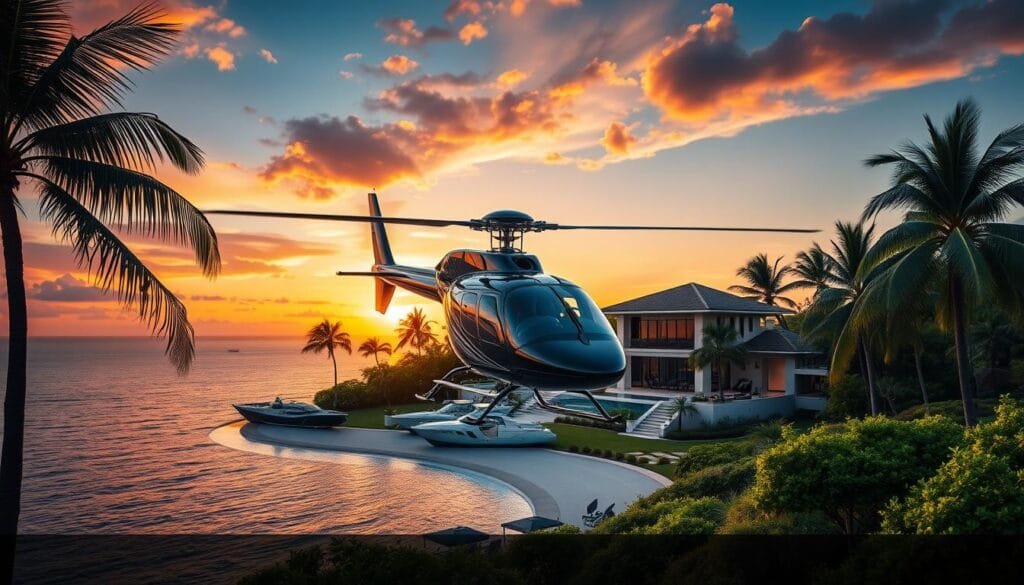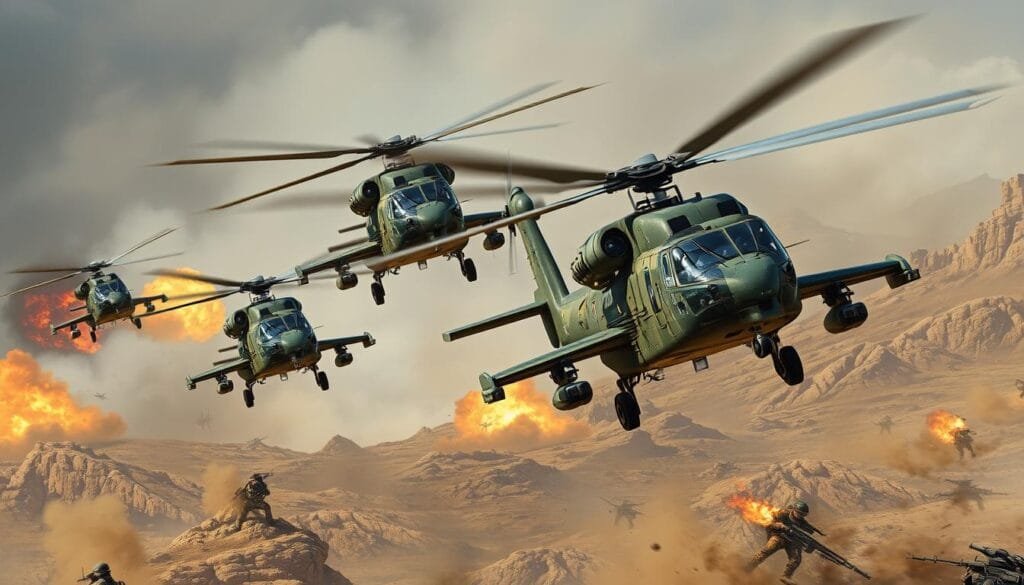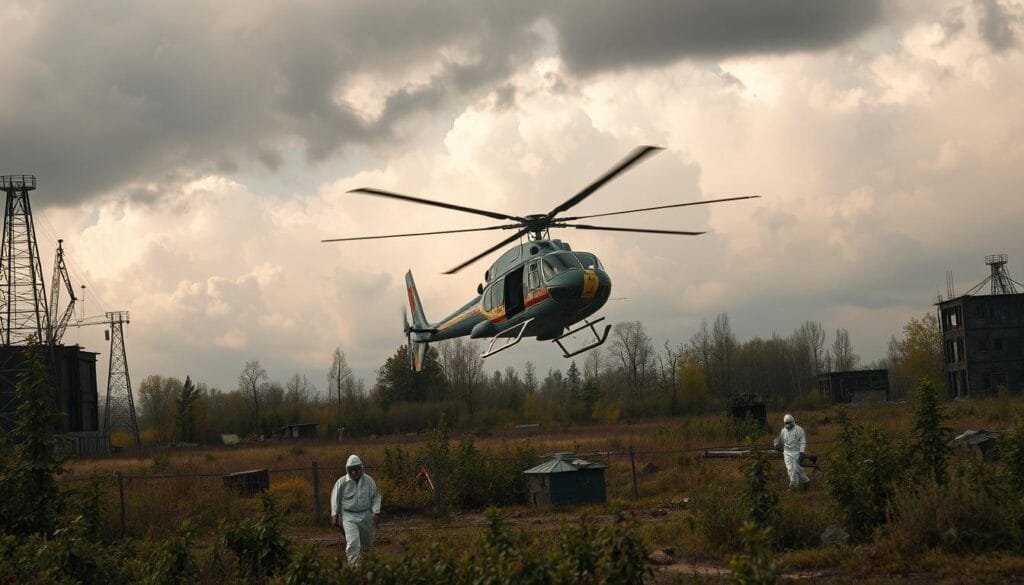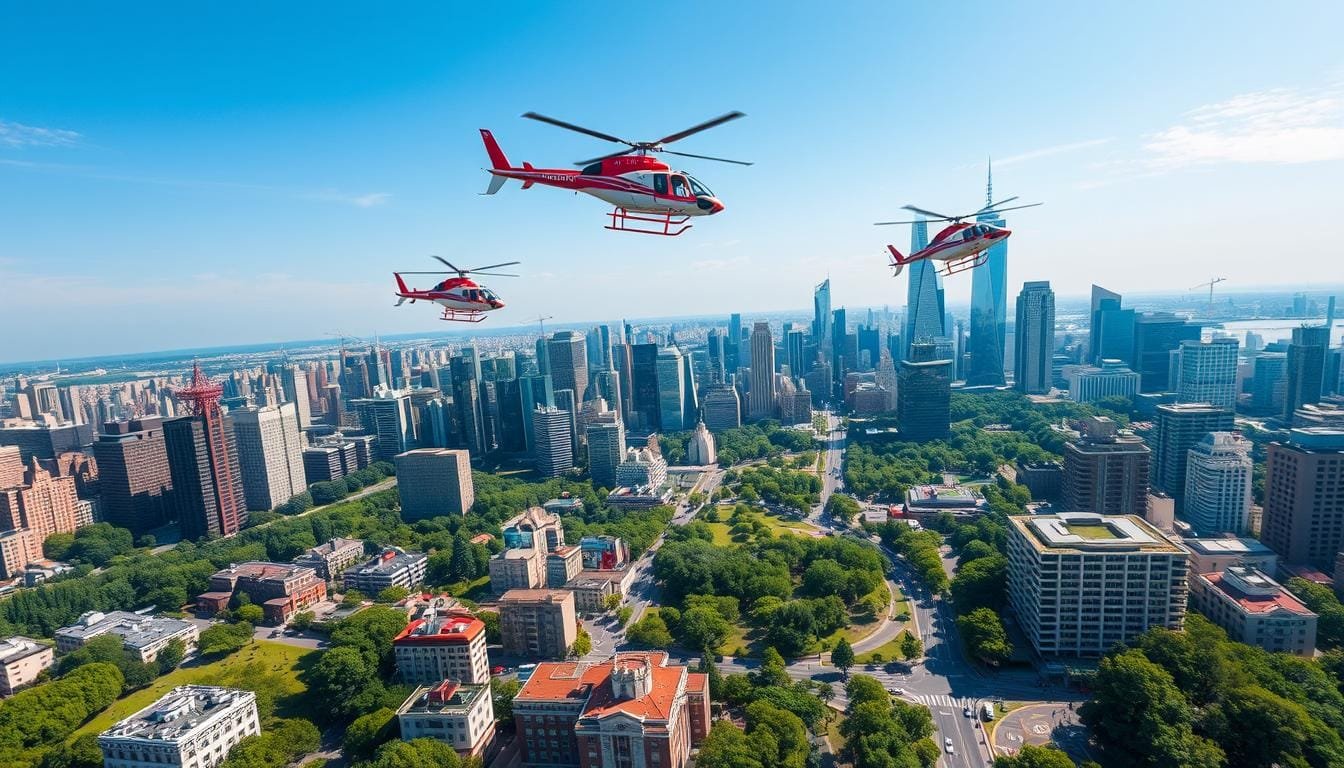Helicopters began with a simple toy in 1784, made by Frenchmen Launoy and Bienvenu. Now, we have advanced helicopters like the Airbus H225M. These machines have changed many parts of our lives. They have grown from curiosities to essential tools. This includes emergency services, military use, and VIP travel. People like Etienne Oehmichen and Sir George Cayley made today’s helicopter uses possible.
Helicopters are now more than amazing engineering achievements. They are key in medical emergency responses, with almost 400,000 rotor-wing medical transports every year in the U.S. They are crucial for moving heavy gear and teams, like in oil and gas work.
But helicopters aren’t just for work. They are also signs of wealth and an easy way to travel for stars and important figures. More importantly, they save lives in natural disasters and tough rescue missions. This shows their true worth to society.
Key Takeaways
- The impact of helicopters spans multiple industries and societal roles.
- From early innovations to modern advancements, helicopter technology has evolved significantly.
- Helicopters are critical in medical emergencies, performing nearly 400,000 transports annually in the U.S.
- They play vital roles in military operations and disaster management.
- Helicopters have also become symbols of prestige and convenient travel for celebrities.
The Birth of the Helicopter and Its Early Uses
The helicopter’s journey is truly fascinating. It started as a dream in 400 CE. But true progress didn’t happen until 1843. That’s when Sir George Cayley introduced ideas that would shape helicopter design. Following that, pioneers like the Breguet brothers and Paul Cornu in 1907 pushed the boundaries further.
A Brief History of Helicopter Development
Inventors in the early 20th century made huge strides. Jacob Ellehammer’s 1912 model had unique features like contrarotating rotors. George de Bothezat’s 1922 helicopter managed a brief flight for the U.S. Army Air Force. Around the same time, Étienne Oehmichen set records with a flight in 1924. By 1936, a German helicopter set high marks in flying. The 1939-41 VS-300 series by Igor Sikorsky showed what was possible, leading to the Sikorsky R-4. This model, made in 1942, was the first fully produced helicopter.
Early Pioneers: Étienne Oehmichen and Others
Helicopter history has many heroes. One is Étienne Oehmichen, who broke records and showed new ways to control helicopters. Others include Raúl Pateras Pescara and the Breguet brothers. Their early work was crucial for what came next.
Initial Applications: Rescues, Military, and More
Early on, helicopters took on big roles. They were perfect for rescue missions in tough spots. The military saw their value in wars like in Vietnam and Afghanistan. They carried troops, saved lives, and fought. After World War II, the world saw even more uses for these amazing flyers.
Below is a table showcasing some key milestones in helicopter history and their impact:
| Year | Milestone | Description |
|---|---|---|
| 1843 | First Scientific Exposition | Sir George Cayley presents principles of vertical flight. |
| 1907 | Significant Development | Breguet brothers and Paul Cornu make important advancements. |
| 1922 | U.S. Army Air Force Helicopter | George de Bothezat’s helicopter achieves a short flight. |
| 1924 | Distance Record | Étienne Oehmichen flies a circular kilometer. |
| 1936 | Focke Achgelis Fa 61 | Germany sets altitude and cross-country flight records. |
| 1942 | Sikorsky R-4 | First helicopter to reach full-scale production. |
How the Helicopter Revolutionized VIP and Celebrity Travel
VIP helicopter travel is a big deal for the elite. It shows wealth and makes traveling easy. Helicopters save time and offer luxury, changing how famous people get around.
A Symbol of Prestige and Convenience
Helicopters mean wealth and easy travel. Airbus Corporate Helicopters (ACH) started in May 2017, focusing on luxury. They work with big names like Hermes and Mercedes-Benz to add more luxury to VIP helicopter travel.
Examples of Famous Helicopter Owners
Stars like Angelina Jolie and Donald Trump love helicopter travel. Jolie even bought one for over $1.6 million in 2012. Other famous helicopter fans include Queen Elizabeth II and Harrison Ford. They show that helicopters are a sign of status.

Risks and Tragedies Involving Celebrity Use
However, helicopter travel has its dangers. The deaths of Kobe Bryant in 2020 and Thai billionaire Vichai Srivaddhanaprabha in 2018 remind us of this. These accidents stress the need for strong safety in helicopter travel.
| Notable Helicopter Owners | Key Details |
|---|---|
| Angelina Jolie | Purchased a helicopter for over $1.6 million in 2012 |
| Donald Trump | Famous for owning multiple helicopters used for business and personal travel |
| Queen Elizabeth II | Utilizes helicopter travel for various royal duties and engagements |
| Harrison Ford | Avid pilot and helicopter owner often seen flying his own aircrafts |
VIP helicopter travel is not just about style. It combines luxury, status, and speed. But, it’s important to remember safety comes first in the skies.
The Role of Helicopters in Modern Warfare
Helicopters have changed warfare in big ways. They bring flexibility and strength to fight. From handling complex battles to moving troops quickly, they are key in today’s military. Let’s look at their role in modern wars.
Key Military Conflicts Involving Helicopters
Helicopters have been vital in many conflicts. In the Vietnam War, the Bell UH-1 Iroquois, or Huey, was essential for moving troops and saving lives. The AH-1G HueyCobra, starting in 1967, was the first helicopter made for attack, helping ground troops a lot.
In the 1980s, in Afghanistan, the Soviet Mil Mi-24 Hind ruled the sky. It was great for both attacking and moving troops. Recently, the AH-64 Apache showed its power in the Persian Gulf War. It’s now a big part of helicopter war plans.

Types of Military Helicopters and Their Capabilities
The design of combat helicopters has created many specialized types. There are transport helicopters, attack helicopters, and multi-role helicopters. Transport ones, like the CH-47 Chinook, can move lots of troops and gear fast.
Attack helicopters, such as the AH-64 Apache, aim to hit enemies hard. They have smart aiming systems and missiles. Multi-role helicopters, like the Eurocopter Tiger, do both fighting and moving, adjusting to changing battles.
Impact on Troop Transportation and Combat Strategies
Helicopters have changed how troops move and fight by letting forces land quickly in many places. They can get into battle areas fast, reducing risk and raising chances of success. Their speed helps in quick strikes and adapting to changes in battle.
Adding helicopters to armies has also led to better support operations. For example, some helicopters now fight submarines using deep-sea sensors and torpedoes. Their technology and weapons keep improving, making them even more vital in military plans.
| Helicopter Model | Role | Notable Conflicts |
|---|---|---|
| Bell UH-1 Iroquois (Huey) | Transport | Vietnam War |
| AH-1G HueyCobra | Attack | Vietnam War |
| Mil Mi-24 Hind | Gunship/Transport | Afghan War |
| McDonnell Douglas AH-64 Apache | Attack | Persian Gulf War |
| CH-47 Chinook | Transport | Various Modern Conflicts |
Military helicopters have fully changed how wars are fought. With the growth of technology, their future looks even brighter. They keep proving they are a crucial part of military power.
Transforming Search and Rescue Operations
Helicopters are key in modern emergencies. They change how we do search and rescue. They’re fast and flexible, perfect for critical moments. These flying machines have saved lives in natural disasters and everyday crises. Let’s look at their impact and the latest advancements.
From Natural Disasters to Daily Emergencies
Helicopters are vital for various emergencies, from natural disasters to daily issues. Take 1988, when seven helicopters helped a Colorado search mission. Two were U.S. Army Chinooks. They can quickly get to hard-to-reach places. Like when they saved rescuers with Acute Mountain Sickness on Pendleton Mountain. Their rotor blades spin over 150 M.P.H., showing off their advanced technology.
Chernobyl Disaster: A Case Study
The 1986 Chernobyl disaster shows how vital helicopter rescues are in severe crises. Helicopters surveyed the area and dropped protective materials on the reactor. The Chernobyl effort proved SAR helicopters’ essential role in handling nuclear accidents. They greatly reduced the disaster’s immediate and long-term risks.

Technological Advancements Enhancing Rescue Missions
Technology has made helicopter rescues better and safer. Artificial intelligence (AI) improves how helicopters are maintained and flown. This means safer, cheaper operations. AI helps pilots avoid obstacles and find the best paths. It’s changing SAR helicopters’ navigation in complex areas.
AI flight simulators are upgrading pilot training, making them skilled faster. But, combining AI with human judgment is crucial for the best results.
| Impact Area | Advancement | Benefit |
|---|---|---|
| Predictive Maintenance | AI Systems | Enhanced Safety, Reduced Costs |
| Navigation | Obstacle Detection, Path Optimization | Improved Efficiency |
| Training | AI-Enabled Simulators | Accelerated Skill Development |
Helicopter rescues are evolving with technology and AI. They play a key role in saving lives during emergencies. With ongoing innovation, SAR helicopters will get even better, providing quick, safe help in the toughest situations.
Helicopters in Crime Fighting and Surveillance
Since the 1960s, police work has changed with law enforcement helicopters. These helicopters became key in controlling public order and fighting crime. For example, the Los Angeles Police Department (LAPD) started with one helicopter in 1956. Now, they have 19 helicopters flying 21 hours each day.
Police helicopters are mainly used for pursuits. In 1995-1996, Baltimore’s helicopter pursuits had an 83% success rate. Miami-Dade had a 91% success rate in 1996. The top reasons for pursuits included stolen cars and robberies. More than half of Baltimore’s pursuits and nearly half in Miami-Dade took place at night. This shows how helicopters, with night vision and infrared cameras, are important.
The tactical flight officer (T.F.O) onboard is crucial. Along with the pilot, the T.F.O listens to various radio frequencies and responds to emergency calls. They can fly up to 170 miles per hour. Their deep knowledge of the area helps stop crimes as they happen.
Helicopters provide a unique view for police, which is crucial for law enforcement. The LAPD can send up to five helicopters in emergencies. This shows their readiness and ability to adapt. Helicopters can make tight turns and fly sideways over crime scenes to improve surveillance.
Police helicopters have greatly improved law enforcement. But, people have raised concerns about noise and the impact on communities. Yet, successes in places like Baltimore and Miami-Dade show the benefits outweigh these concerns. Community leaders and researchers are looking into how these helicopters affect places like Los Angeles.
Helicopters and Their Impact on Construction and Industry
Helicopter technology has completely changed construction and industry. Construction and industrial helicopters are now key in many operations. They have introduced new ways to work, but also pose some environmental issues.
Revolutionizing Construction Sites
Construction helicopters have changed how we build. They transport materials and machines quickly to hard-to-reach places. This makes projects finish faster and lessens reliance on ground equipment.
Transporting Heavy Equipment and Personnel
Industrial helicopters, like the Bell 205A-1++, are great for moving heavy items and people. They can carry up to 4,000 pounds. This is especially useful in tough terrains or far-off places.
Environmental Benefits and Challenges
Helicopters in construction help and hurt the environment. They reduce the need for large vehicles, which can be good for the land. But, they also create noise and depend on fossil fuels which are bad.
| Helicopter Model | Max Load Capacity | Common Uses |
|---|---|---|
| Bell 205A-1++ | 4,000 lbs | Heavy-lift operations in construction |
| Kaman K-Max K-1200 | 6,000 lbs | Wind turbine installations, energy construction |
Construction helicopters are crucial to our industries. Yet, to truly benefit from them, we need to balance their use with environmental care.
how did the helicopter impact society
Helicopters have changed society deeply, touching areas like healthcare and tourism. They’ve made emergency medical services better. They’ve also made tourism more thrilling with amazing aerial views.
Influencing Various Sectors: Medical, Tourism, and More
Various sectors have seen big benefits from helicopters, improving how they work and serve people. They bring fast medical help from the sky and unique travel adventures. The way helicopters have changed things is clear.
Medical Air Ambulances and Their Critical Role
Helicopters play a key role in medical services. They quickly get patients to hospitals when every second counts. This saves lives during emergencies.
They’re also key in rescue missions. They can move people quickly out of danger. This shows how vital they are.
- Helicopters move over 300,000 people each year, even in bad weather. This shows how well they work for public transport.
- They’re very important for quick medical help and responding to emergencies. This has greatly improved chances of survival in serious situations.
Tourism: Offering Aerial Views and Unique Experiences
Helicopter tourism lets people see famous places from the sky. You can see the Grand Canyon and Victoria Falls like never before. It’s a favorite for those seeking adventure and love to travel.
- They let you see landscapes and sights in a new way.
- They save time compared to older travel ways.
Helicopters really have a big impact on society. They connect far places and make many services better. As we invent more, helicopters will become even more important in our lives.
Conclusion
The journey of helicopters from Leonardo da Vinci’s ideas to today’s advanced models is extraordinary. We’ve explored how they’ve impacted aviation and society. Their evolution highlights innovation and adaptability.
Helicopters started in search and rescue and military tasks. Now, they’re crucial for VIP transport, policing, and building projects. The 1950s’ turbine engines boosted their design and efficiency. Today’s innovations, like self-flying cranes and cutting-edge avionics, expand their uses.
Looking ahead, electric and hybrid helicopters offer promise. They aim for cleaner, more efficient flights, supporting global sustainability efforts. Helicopters are key for future challenges and chances. With ongoing technological advances, their importance will only grow.
FAQ
What is the historical significance of helicopters?
Since 1921, helicopters have changed how we do many things. They’ve impacted transportation, military, and medical emergencies. This has deeply influenced our society.
Who were some of the early pioneers in helicopter development?
One key pioneer was Etienne Oehmichen, who flew successfully in 1921. Their work paved the way for helicopter innovation.
How have helicopters been used in military operations?
In the military, helicopters are vital. They move troops, engage in combat, and conduct rescues. They’ve been key in many conflicts, changing military tactics.
What makes helicopters a symbol of prestige among VIPs and celebrities?
Helicopters offer quick and convenient travel, making them prestigious. People like Donald Trump and celebrities such as Angelina Jolie have used helicopters.
What are the risks associated with VIP helicopter travel?
Even with their convenience, helicopters come with dangers. Sadly, accidents have occurred, involving stars like Kobe Bryant, pointing to their risks.
How have helicopters revolutionized search and rescue operations?
Helicopters have changed search and rescue efforts dramatically. They’re quick to respond to disasters and emergencies, proven by their role during the Chernobyl event.
What technological advancements have enhanced helicopter rescue missions?
Technology has made rescue helicopters much more efficacious. Improved navigation and stability controls mean they perform better in difficult conditions.
How are helicopters utilized in law enforcement and surveillance?
Police helicopters are crucial in maintaining order. They assist in pursuits, finding missing people, and crowd control, using night vision and infrared tech.
In what ways have helicopters impacted the construction industry?
Helicopters have revolutionized construction by moving heavy gear and workers to tough spots. They lessen the environmental harm tied to ground machines.
What are some environmental challenges associated with helicopter use?
Helicopters create noise pollution and rely on fossil fuels. Overcoming these environmental hurdles is essential for eco-friendly development in construction and other areas.
How have helicopters influenced sectors like healthcare and tourism?
In healthcare, helicopters save lives as air ambulances. In tourism, they provide unique views of places like the Grand Canyon, making trips memorable.
